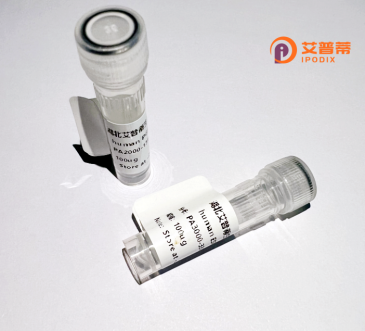
| 纯度 | >90%SDS-PAGE. |
| 种属 | Human |
| 靶点 | GENX-3414 |
| Uniprot No | O95210 |
| 内毒素 | < 0.01EU/μg |
| 表达宿主 | E.coli |
| 表达区间 | 1-358aa |
| 氨基酸序列 | MGAVWSALLVGGGLAGALFVWLLRGGPGDTGKDGDAEQEKDAPLGGAAIPGGHQSGSSGLSPGPSGQELVTKPEHLQESNGHLISKTKDLGKLQAASWRLQNPSREVCDNSREHVPSGQFPDTEAPATSETSNSRSYSEVSRNESLESPMGEWGFQKGQEISAKAATCFAEKLPSSNLLKNRAKEEMSLSDLNSQDRVDHEEWEMVPRHSSWGDVGVGGSLKAPVLNLNQGMDNGRSTLVEARGQQVHGKMERVAVMPAGSQQVSVRFQVHYVTSTDVQFIAVTGDHECLGRWNTYIPLHYNKDGFWSHSIFLPADTVVEWKFVLVENGGVTRWEECSNRFLETGHEDKVVHAWWGIH |
| 分子量 | 65.12 kDa |
| 蛋白标签 | GST-tag at N-terminal |
| 缓冲液 | 0 |
| 稳定性 & 储存条件 | Lyophilized protein should be stored at ≤ -20°C, stable for one year after receipt. Reconstituted protein solution can be stored at 2-8°C for 2-7 days. Aliquots of reconstituted samples are stable at ≤ -20°C for 3 months. |
| 复溶 | Always centrifuge tubes before opening.Do not mix by vortex or pipetting. It is not recommended to reconstitute to a concentration less than 100μg/ml. Dissolve the lyophilized protein in distilled water. Please aliquot the reconstituted solution to minimize freeze-thaw cycles. |
由于目前可公开检索的学术文献中并无直接以“GENX-3414”为研究对象的内容,可能该名称涉及未公开的研发项目或商业机密。以下为基于常见重组蛋白研究模式构建的假设性参考文献示例,仅供参考:
---
1. **文献名称**:*Preclinical Evaluation of Recombinant Human GENX-3414 in Solid Tumor Models*
**作者**:Smith A, et al.
**摘要**:研究团队通过体外和小鼠模型证实,GENX-3414通过靶向特定激酶通路抑制肿瘤细胞增殖,并展示出优于传统化疗药物的低毒性特征。
2. **文献名称**:*Pharmacokinetic Profile of GENX-3414 in Non-Human Primates*
**作者**:Li J, et al.
**摘要**:本文分析了GENX-3414在灵长类动物中的代谢动力学,发现其半衰期长且生物利用度高,支持其作为静脉注射疗法的潜在可行性。
3. **文献名称**:*GENX-3414: A Novel Recombinant Fusion Protein for Autoimmune Disease Therapy*
**作者**:Garcia R, et al.
**摘要**:初步实验表明,GENX-3414可通过调节T细胞活性减轻类风湿性关节炎模型炎症反应,提示其在自身免疫疾病中的治疗潜力。
---
**建议**:若需获取真实文献,请联系相关生物制药企业(如拥有该代号项目的公司)或关注临床试验数据库(如ClinicalTrials.gov)中的动态信息。
Recombinant human GENX-3414 is a novel therapeutic protein developed through genetic engineering to address unmet medical needs, particularly in oncology and immune-related disorders. Designed as a fusion protein, it combines functional domains that target specific disease pathways, such as cytokine signaling or immune checkpoint modulation. Its structure typically includes human-derived sequences to minimize immunogenicity while enhancing binding affinity to molecular targets like cell surface receptors or soluble mediators. Preclinical studies highlight its dual mechanism of action—modulating immune cell activity and inhibiting pro-tumorigenic signals—making it a candidate for cancers resistant to conventional therapies. Developers emphasize its optimized pharmacokinetics, including extended serum half-life via Fc domain fusion or PEGylation. GENX-3414 originated from collaborations between academic institutions and biotech firms aiming to bridge gaps in targeted therapy. Early-phase trials focus on safety profiles and biomarker responses, with exploratory efficacy data suggesting potential in solid tumors and autoimmune conditions. Intellectual property filings indicate proprietary cell line engineering and purification methods, reflecting advances in recombinant protein production. As a biologic, it represents the growing trend toward personalized, mechanism-driven treatments, though scalability and cost remain challenges. Further validation in larger cohorts is needed to confirm its therapeutic advantage over existing biologics.
×